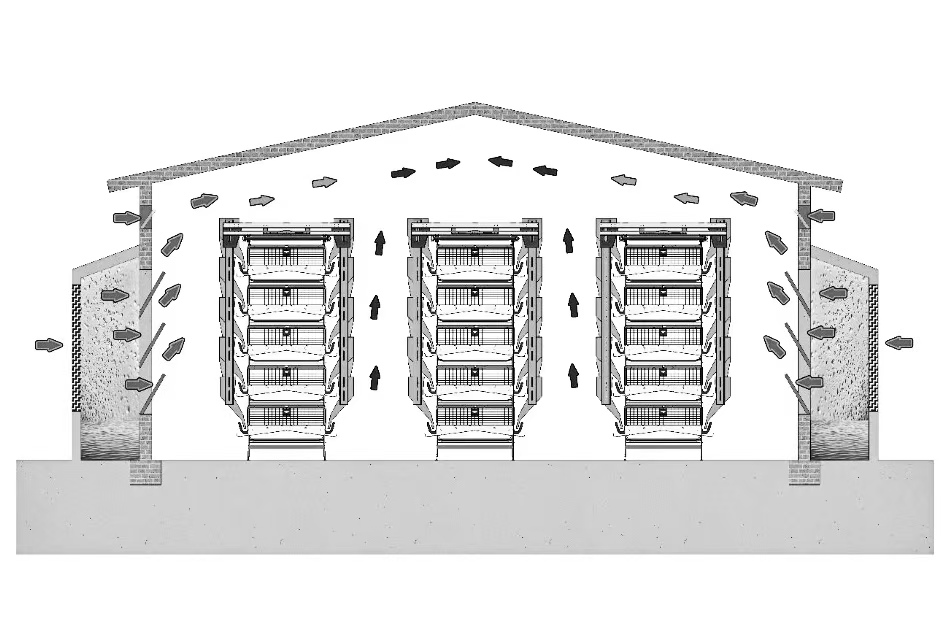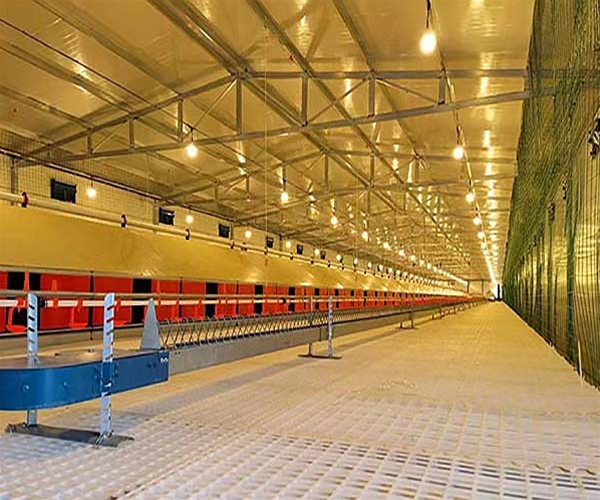Large chicken house with the continuous development of modern agriculture, more and more farms are choosing to use automated equipment and intelligent systems. These systems help improve production efficiency, reduce labor costs, and optimize space. Stacked poultry cages are widely used in chicken houses, especially in large-scale farms. This article will explore how to effectively use stacked poultry cages in large chicken houses. It will also discuss how these cages help farms improve space utilization, increase production efficiency, and enhance chicken health management.
The Design Challenges of Large Chicken House
For large-scale farms, chicken house design is crucial. In poultry farming, space utilization directly affects production efficiency and animal welfare. Traditional free-range chicken houses often require large amounts of land and space. While this design provides chickens with relatively spacious living areas, it is often not suitable for large-scale farming needs.
One of the main challenges of large chicken houses is how to accommodate more chickens in a limited space. At the same time, it is important to ensure that they stay healthy and efficient in egg-laying or broiler production. This requires innovative designs and equipment to resolve the conflict between space and efficiency.
Stacked Poultry Cages: The Solution to Optimize Space in Large Chicken House
Stacked poultry cages are specifically designed to address this issue. Unlike traditional ground or free-range farming systems, stacked poultry cages allow chickens to be arranged in multiple tiers. This significantly saves vertical space, enabling more chickens to be housed in the same footprint. This type of equipment is widely used in modern farming, particularly in commercial farming environments where space efficiency is critical.
1. Saving Space and Increasing Density
In traditional chicken house designs, the number of chickens is often limited by the available floor space. Each chicken needs a certain amount of room to move. However, with stacked poultry cages, chickens are housed in multiple tiers of cages. This reduces the horizontal space requirements. With proper design, stacked cages can increase the number of tiers. More chickens can be housed vertically, improving space utilization.
For example, in a standard stacked cage system, there may be 3-5 tiers of cages. By using vertical space, more chickens can be housed without increasing the land area. This provides significant economic benefits for large-scale commercial farms.
2. Improving Management Efficiency
Stacked poultry cages not only optimize space but also improve management efficiency. By integrating automated feeding, drinking, and manure removal systems, farm managers can streamline daily operations. For instance, automated feeding systems ensure that chickens receive a balanced diet. This reduces the time and labor needed for manual feeding. Similarly, automated manure removal systems help minimize cleaning tasks. This reduces the risk of disease caused by manure buildup.
For large chicken houses, the use of automation greatly enhances management efficiency. It also reduces labor costs. By integrating equipment, farms can operate more efficiently and allow staff to focus on other critical tasks.
3. Improving Chicken Health and Welfare
While stacked poultry cages limit the chickens’ horizontal movement, good design ensures their health and welfare. Modern stacked cage systems are typically equipped with comfortable perches and adequate ventilation. This helps maintain an ideal environmental temperature and humidity, promoting the health of the chickens.
In addition, stacked cage designs usually help separate different chickens. This reduces conflicts and stress between them, lowering the risk of disease transmission. By optimizing ventilation and temperature control systems in the chicken house, the air circulation on each tier can be maintained. This keeps the environment hygienic and minimizes the risk of illness.
Large Chicken House——Choosing the Right Stacked Poultry Cage System
When choosing a stacked poultry cage system, farms need to consider several factors. These include the size of the chicken house, the type of chickens, the integration of automation systems, and the durability and ease of maintenance of the equipment. Different types of stacked cages are suitable for different farming needs. It’s important to select the right system based on the specific requirements.
- Number of Tiers and Size: Depending on the height and area of the chicken house, choose an appropriate number of cage tiers. For large chicken houses, multi-tier designs are often preferred. This maximizes vertical space. The size of the cages should be chosen based on the size of the chickens. This ensures they have enough room to move.
- Automation Systems: Modern stacked poultry cages are equipped with various automation features. These include automatic feeding, drinking, and manure removal. These systems increase management efficiency and reduce labor costs. For large farms, automation is especially important. It helps improve production efficiency and reduces the need for manual labor.
- Durability and Maintenance: Choose materials and equipment that are durable, easy to clean, and easy to maintain. High-quality stacked poultry cages reduce the likelihood of breakdowns. They also lower maintenance costs, ensuring the equipment runs smoothly over the long term.
Conclusion
In conclusion, using stacked poultry cages in large chicken houses is an ideal solution for optimizing space and increasing production efficiency. By designing chicken houses properly and using advanced stacked cage systems, farms can significantly improve space utilization. This also increases management efficiency, enhances chicken health, and reduces labor costs. When selecting stacked poultry cages, farms need to make informed decisions based on their scale and specific needs. They should ensure that the equipment is of high quality and performance.
With the continuous development of modern farming technologies, the use of stacked poultry cages will become the standard choice for more large-scale farms. This will help them enhance overall operational efficiency and productivity, while contributing to the sustainable development of the industry.


